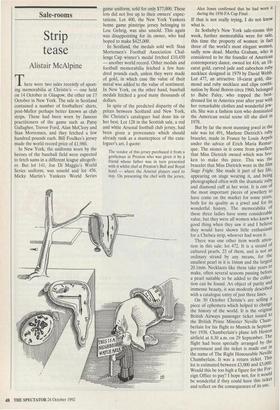Sale-rooms
Strip tease
Alistair McAlpine
There were two sales recently of sport- ing memorabilia at Christie's — one held on 14 October in Glasgow, the other on 17 October in New York. The sale in Scotland contained a number of footballers' shirts, post-Mellor perhaps better known as club strips. These had been worn by famous practitioners of the game such as Patsy Gallagher, Trevor Ford, Alan McClory and Stan Mortensen, and they fetched a few hundred pounds each. Bill Foulkes's jersey made the world record price of £1,980.
In New York, the uniforms worn by the heroes of the baseball field were expected to fetch sums in a different league altogeth- er. But lot 141, Joe Di Maggio's World Series uniform, was unsold and lot 456, Micky Martin's Yankees World Series game uniform, sold for only $77,000. These lots did not live up to their owners' expec- tations. Lot 400, the New York Yankees home game pinstripe jersey belonging to Lou Gehrig, was also unsold. This again was disappointing for its owner, who had hoped to make $425,000.
In Scotland, the medals sold well. Stan Mortensen's Football Association Chal- lenge Cup winner's medal fetched £10,450 — another world record. Other medals and football memorabilia fetched a few hun- dred pounds each, unless they were made of gold, in which case the value of their metal was added to the value of sentiment. In New York, on the other hand, baseball medals fetched a good many thousands of dollars.
In spite of the predicted disparity of the prices between Scotland and New York, the Christie's cataloguer had done his or her best. Lot 128 in the Scottish sale, a red and white Arsenal football club jersey, had been given a provenance which should already rank as a masterpiece of the cata- loguer's art. I quote:
The vendor of this jersey purchased it from a gentleman in Preston who was given it by a friend whose father was in turn presented with it whilst chef at Preston's Bull and Royal hotel — where the Arsenal players used to stay. On presenting the chef with the jersey, Alex Jones confirmed that he had worn it during the 1936 FA Cup Final.
If that is not really trying, I do not know what is.
In Sotheby's New York sale-rooms this week, further memorabilia were for sale, this time the property of women: in fact three of the world's most elegant women, sadly now dead. Martha Graham, who is considered to be the founder of American contemporary dance, owned lot 416, an 18- carat gold, carved jade and cabochon ruby necklace designed in 1979 by David Webb. Lot 477, an attractive 18-carat gold, dia- mond and ruby necklace and clips combi- nation by Rene Boivin circa 1960, belonged to Babe Paley, who topped the best- dressed list in America year after year with her remarkable clothes and wonderful jew- els. She was a fashion icon who dominated the American social scene till she died in 1978.
But by far the most stunning jewel in the sale was lot 491, Marlene Dietrich's ruby bracelet, made in France by Louis Arpels under the advice of Erich Maria Remar- que. The stones in it come from jeweller that Miss Dietrich owned which was bro- ken to make this piece. This was the bracelet that Miss Dietrich wore in the film Stage Fright. She made it part of her life, appearing on stage wearing it, and being photographed often with the dramatic ruby and diamond cuff at her wrist. It is one of the most important pieces of jewellery to have come on the market for some years, both for its quality as a jewel and for its wonderful history. The memorabilia of these three ladies have some considerable value, but they were all women who knew a good thing when they saw it and I believe they would have shown little enthusiasm for a Chelsea strip, whoever had worn it.
There was one other item worth atten- tion in this sale: lot 472. It is a strand of cultured pearls, 23 of them, and is not an ordinary strand by any means, for the smallest pearl in it is 16mm and the largest 20.1mm. Necklaces like these take years to make, often several seasons passing before a pearl suitable to be added to the collec- tion can be found. An object of purity and immense beauty, it was modestly described with a catalogue entry of just three lines. On 30 October Christie's are selling a piece of ephemera which helped to change the history of the world. It is the original British Airways passenger ticket issued to the British Prime Minister Neville Cham- berlain for his flight to Munich in Septem- ber 1938. Chamberlain's plane left Heston airfield at 8.30 a.m. on 29 September. The flight had been specially arranged by the government and the ticket is made out. in the name of The Right Honourable Neville Chamberlain. It was a return ticket. This lot is estimated between £3,000 and £5,000. Would this be too high a figure for the For- eign Office to pay? I hope not, for it would be wonderful if they could have this ticket and reflect on the consequences of its use.


































































 Previous page
Previous page